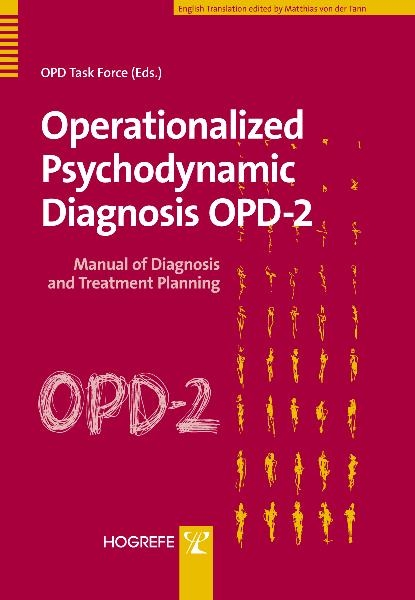
Operationalized Psychodynamic Diagnosis OPD-2
Hogrefe & Huber (Verlag)
978-0-88937-353-2 (ISBN)
"OPD-2" is a new edition of the multiaxial diagnostic system for psychodynamically oriented therapists and psychiatrists, now with practical tools and procedures for treatment planning and for measuring change.Operationalized Psychodynamic Diagnosis (OPD) is a form of multiaxial diagnostic and classification system based on psychodynamic principles, analogous to those based on other principles such as DSM-IV and ICD-10. The OPD is based on five axes: I - experience of illness and prerequisites for treatment, II - interpersonal relations, III - conflict, IV - structure, and V - mental and psychosomatic disorders (in line with Chapter V (F) of the ICD-10). After an initial interview lasting 1-2 hours, the clinician (or researcher) can evaluate the patient's psychodynamics according to these axes and enter them in the checklists and evaluation forms provided. The new version, OPD-2, has been developed from a purely diagnostic system to include a set of tools and procedures for treatment planning and for measuring change, as well as for determining the appropriate main focuses of treatment and developing appropriate treatment strategies.
Foreword by Otto F. Kernberg and John F. Clarkin; Preface; OPD Task Force; 1. Theoretical Background; 1.1 From OPD-1 to OPD-2; 1.2 Aims of the OPD Task Force; 1.3 The Concept of the Operationalized Psychodynamic Diagnosis (OPD); 1.4 Fundamental Considerations on a Multiaxial Diagnosis; 1.5 On the Operationalization of Psychoanalytic Constructs; 1.6 Past Approaches of Operationalization of Psychodynamic Constructs; 1.7 Limits of the OPD; 2. Experiences and Empirical Findings with OPD-1; 2.1 Quality Criteria of OPD-1; 2.2 Axis I: "Experience of Illness and Prerequisites for Treatment"; 2.3 Axis II: "Interpersonal Relations"; 2.4 Axis III: "Conflict"; 2.5 Axis IV: "Structure"; 2.6 Conclusion; 3. Operationalization of the Axes According to OPD-2; 3.1 Axis I - Experience of Illness and Prerequisites for Treatment; 3.2 Axis II - Interpersonal Relations; 3.3 Axis III - Conflict; 3.4 Axis IV - Structure; 3.5 Axis V - Mental and Psychosomatic Disorders; 3.6 Conceptual Cross-References and Interactions Between the Axes; 4. Manualization of the Axes According to OPD-2; 4.1 Axis I - Experience of Illness and Prerequisites for Treatment; 4.2 Axis II - Interpersonal Relations; 4.3 Axis III - Conflict; 4.4 Axis IV - Structure; 5. The OPD Interview; 5.1 The Theory of the Psychodynamic Interview; 5.2 Carrying out the OPD Interview; 6. Case Example: "Driven out from Paradise"; 6.1 Interview Vignette; 6.2 Case Evaluation and Documentation; 6.3 Comments on the Evaluation; 7. Focus Selection and Treatment Planning; 7.1 Establishing the Indication for Treatment on the Basis of OPD Axis I; 7.2 Determination of Foci on the Basis of OPD Axes II-IV; 7.3 Principles of Focus Selection; 7.4 Component Parts of the Foci; 7.5 Treatment Planning and Therapeutic Aims; 7.6 Peculiarities of the Psychodynamic Work on Dysfunctional Relationship Patterns; 7.7 Concluding Remarks; 8. Change Measurement with OPD; 8.1 OPD and Change Measurement: Basic Considerations; 8.2 Model of an OPD-based Change Measurement; 8.3 Reliability and Validity; 8.4 Clinical Application; 9. Areas of Application and Quality Assurance; 9.1 Quality Assurance in Psychotherapy and the Law; 9.2 Quality Assurance in Psychodynamic Psychotherapies (QPP); 9.3 OPD in the Expert Assessment Procedure of the German Psychotherapy Guidelines; 9.4 OPD in Inpatient Treatment in Psychosomatic-Psychotherapeutic Hospitals; 9.5 OPD in the Psychosomatic Rehabilitation Treatment; 9.6 Training, Continuing Education, and Post-Graduate Study; 9.7 OPD and Expert Opinion; 10. Continuing Education and Post-Graduate Study (with a List of Addresses); 11. References; 12. Addresses of Authors; 13. Tools for Working with OPD; 13.1 Axis I - Forensic Module; 13.2 Axis II; 13.3 OPD-2 Conflict Checklist; 13.4 The OPD-2 Structure Checklist; 1.1 Cognitive ability: Self-perception; 13.5 Heidelberg Structural Change Scale; 13.6 Interview Tools; 13.7 Operationalized Psychodynamic Diagnosis (OPD-2) Data Evaluation Forms; 13.8 Data Evaluation Sheet Forensic Module; 13.9 Data Evaluation Sheet Focus Selection; 14. Additional Modules; 14.1 The GAF (Global Assessment of Functioning) Scale; 14.2 EQ-5D; 14.3 List of Defence Mechanisms.
| Vorwort | Otto Friedmann Kernberg, John F. Clarkin |
|---|---|
| Zusatzinfo | 22 tables, 14 figures |
| Verlagsort | Toronto |
| Sprache | englisch |
| Maße | 153 x 229 mm |
| Themenwelt | Geisteswissenschaften ► Psychologie ► Persönlichkeitsstörungen |
| Medizin / Pharmazie ► Medizinische Fachgebiete ► Psychiatrie / Psychotherapie | |
| ISBN-10 | 0-88937-353-1 / 0889373531 |
| ISBN-13 | 978-0-88937-353-2 / 9780889373532 |
| Zustand | Neuware |
| Haben Sie eine Frage zum Produkt? |
aus dem Bereich


